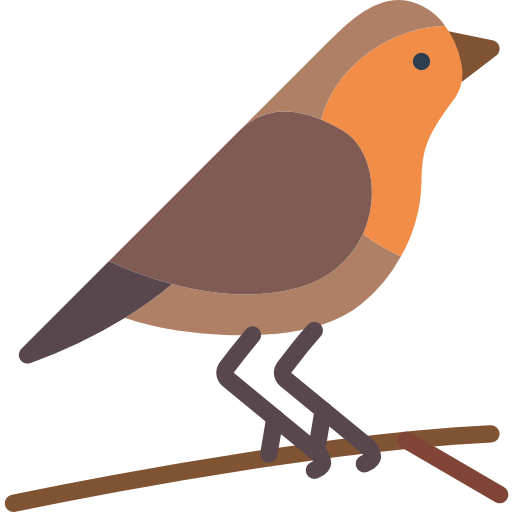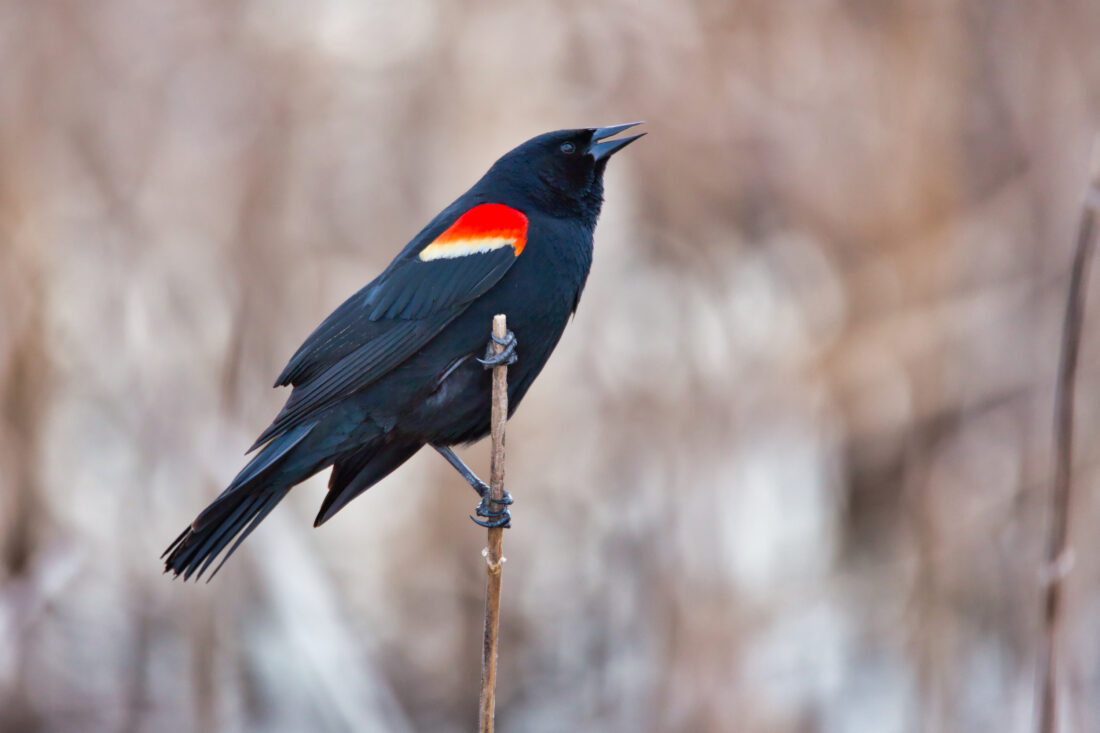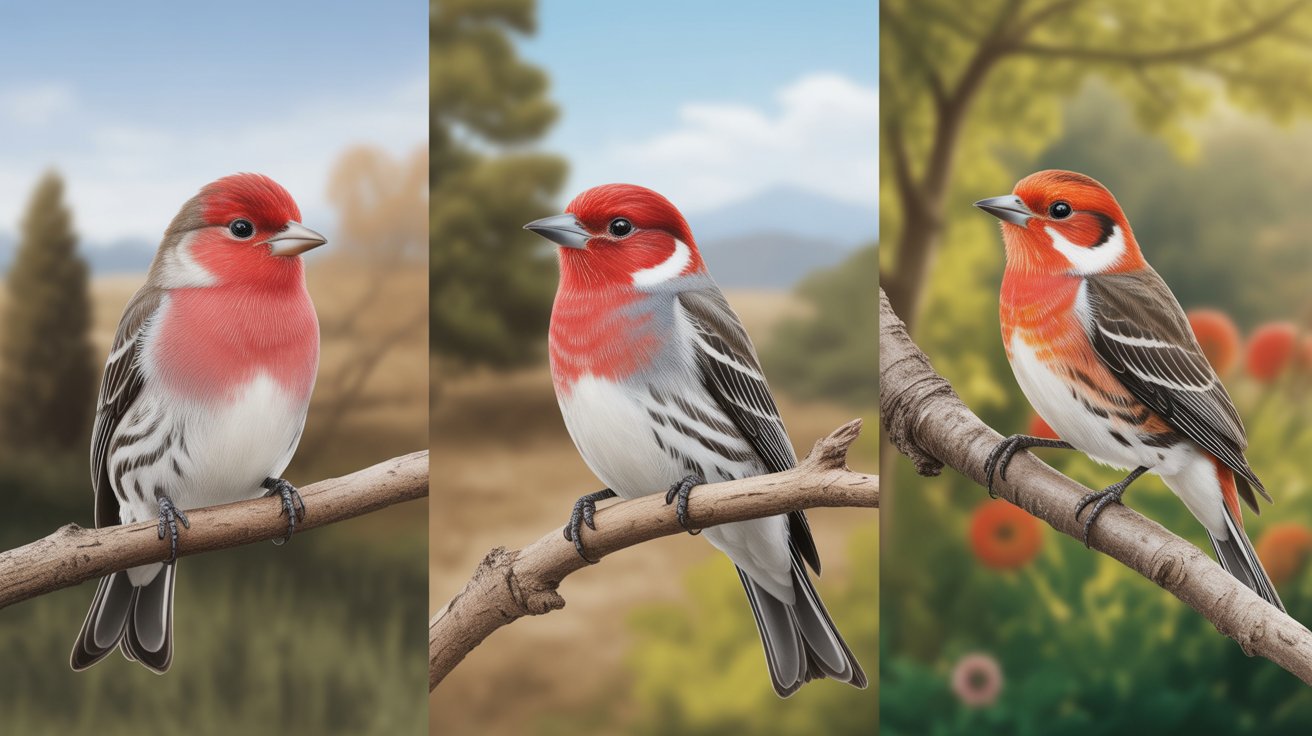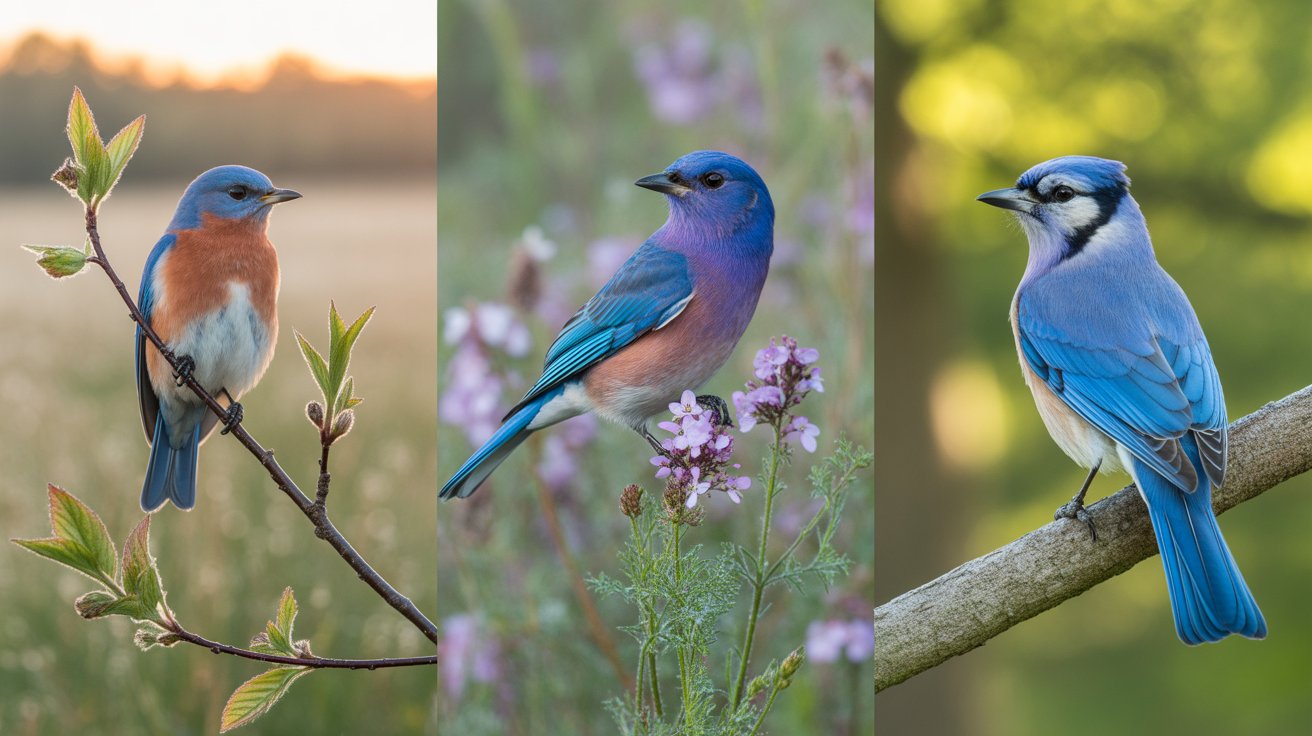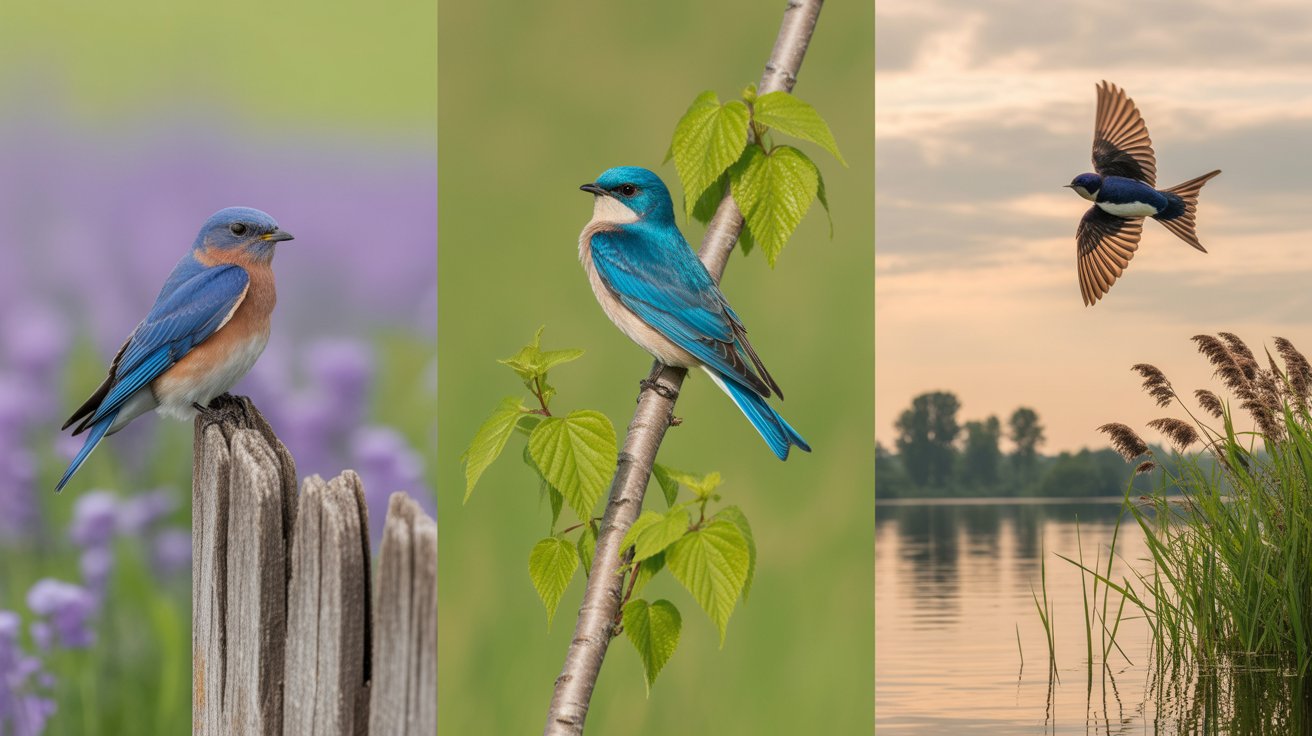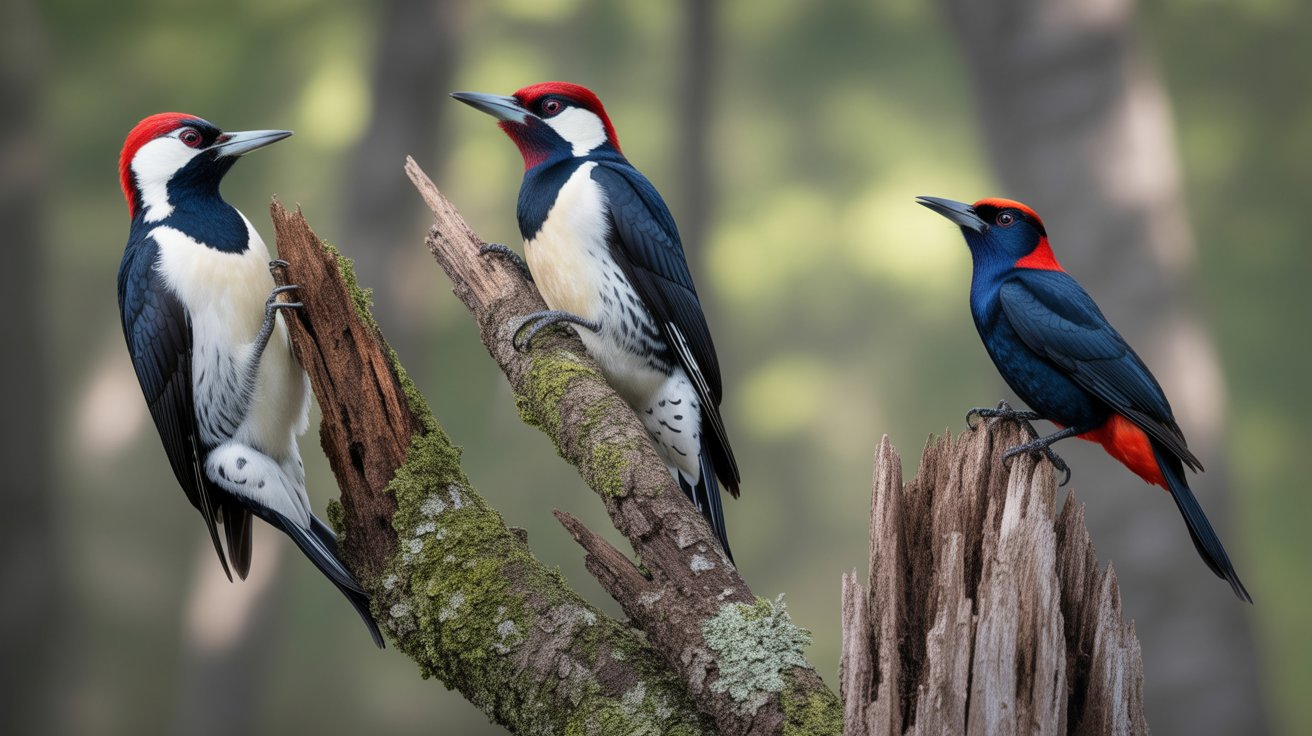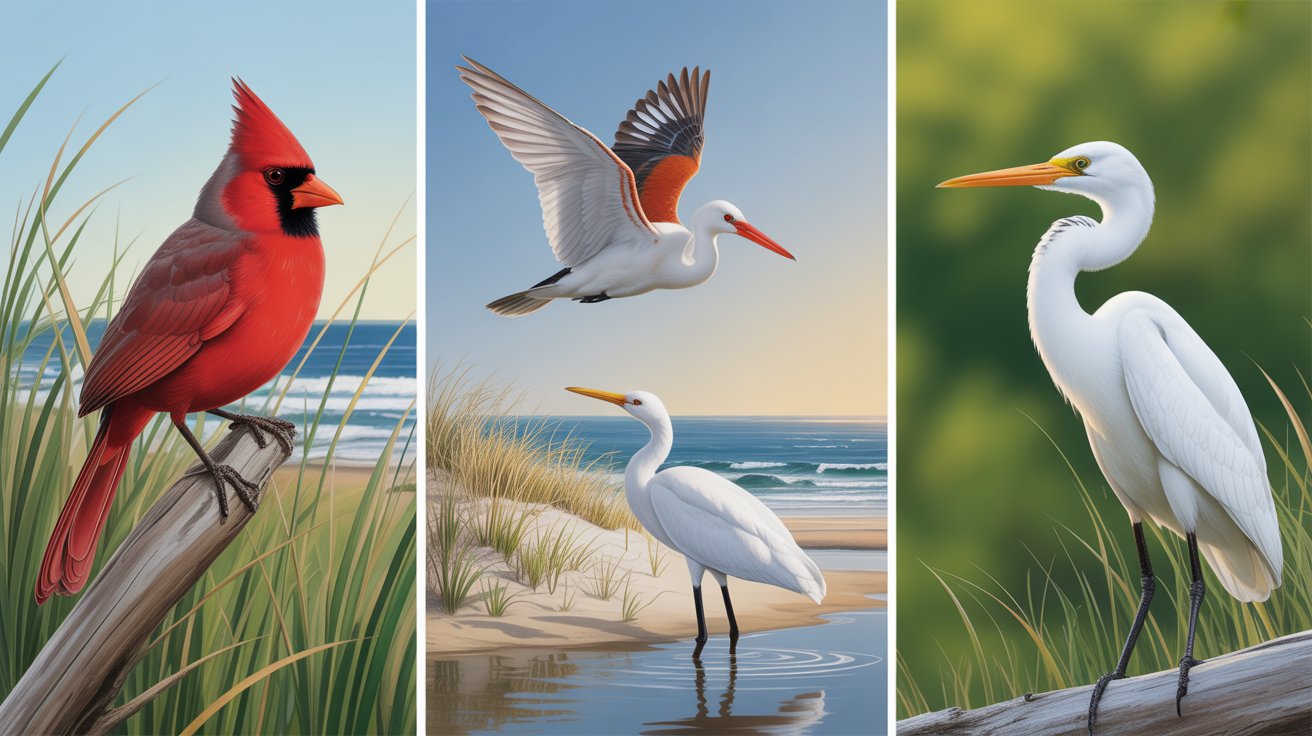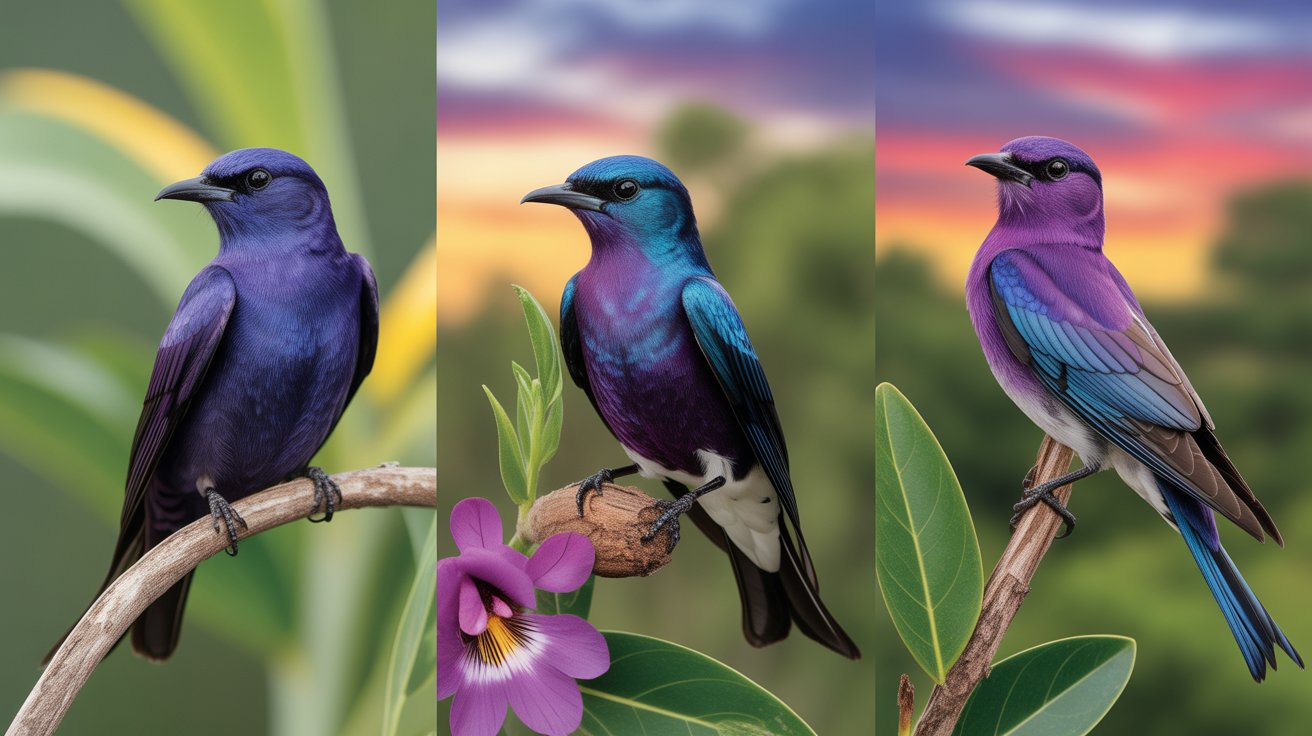Have you ever spotted a striking black bird with a bold white stripe on its wings and wondered what species it might be? You’re not alone. These birds grab your attention instantly. Whether you’re a backyard birdwatcher, a nature photographer, or just someone who appreciates the beauty of wildlife, black birds with white wing markings are fascinating to observe.
What makes these birds even more intriguing is how diverse they are. From small, energetic songbirds to larger, commanding raptors, these contrasting colors serve a variety of purposes—from camouflage and mating displays to startling predators during flight.
In this article, you’ll explore a handpicked list of more than 18 birds that match this unique visual trait. Each section gives you detailed insights into the bird’s appearance, behavior, habitat, and key identification traits. You’ll also get helpful facts like wingspan, scientific name, and more. Whether you’re birding in North America, Europe, or Asia, chances are you’ll come across at least a few from this list.
So grab your binoculars—or just your curiosity—and let’s explore the fascinating world of black birds with white stripes on their wings.
Contents
- 1. Red-winged Blackbird
- 2. White-winged Triller
- 3. Black-and-white Warbler
- 4. Eurasian Magpie
- 5. Lark Bunting
- 6. White-winged Black Tern
- 7. Black-winged Stilt
- 8. White-winged Crossbill
- 9. Northern Mockingbird (Juvenile)
- 10. White-winged Dove
- 11. Willie Wagtail
- 12. Eastern Kingbird
- 13. White-winged Scoter
- 14. Common Black Hawk
- 15. Magpie-lark (Peewee)
- 16. Black Phoebe
- 17. Pied Triller
- 18. White-shouldered Starling
- 19. Black-collared Starling
- FAQs
- Conclusion
1. Red-winged Blackbird
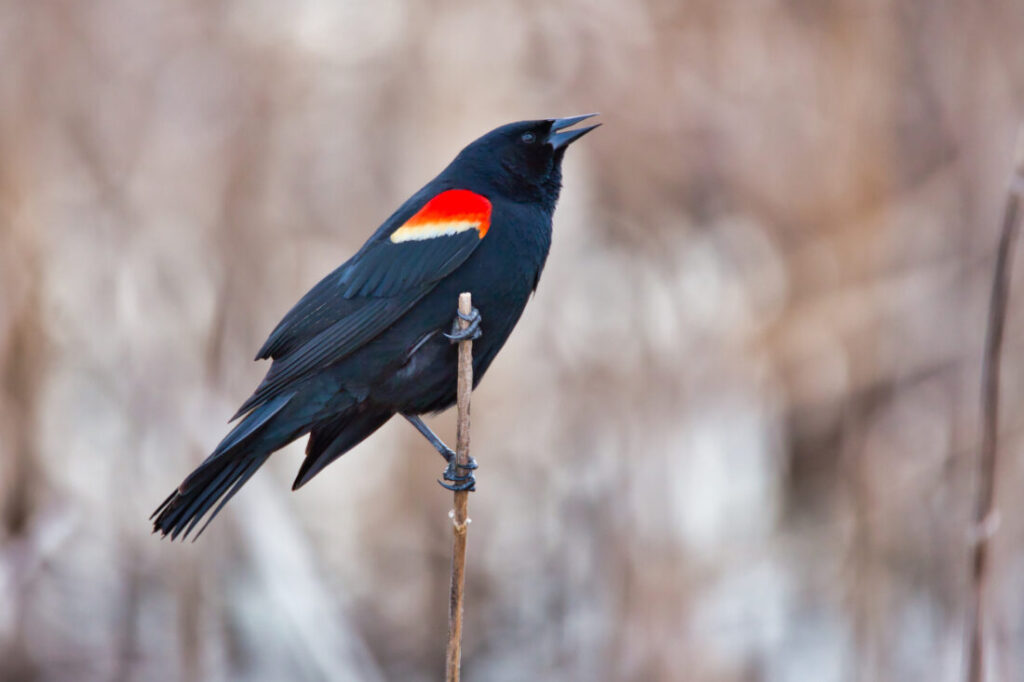
The Red-winged Blackbird is one of the most easily identifiable black birds in North America. Males have jet-black plumage with bold red and white (or yellowish) shoulder patches, especially visible when the wings are spread.
This bird thrives in wetlands, marshes, and fields. Males are highly territorial and are often heard before they are seen, thanks to their loud, conk-la-ree call.
- Scientific Name: Agelaius phoeniceus
- Wingspan: 12 to 16 inches
- Length: 6.7 to 9.1 inches
- Weight: 1.1 to 2.7 ounces
Red-winged Blackbirds are known for their aggressive nesting behavior, even chasing away much larger birds like hawks or crows. If you’re near water, keep an eye out for these striking birds perched on cattails or wires.
2. White-winged Triller
Native to Australia, the White-winged Triller is a small black-and-white bird found in woodlands and open scrub. The male is glossy black with a prominent white stripe running across its wing, giving it an elegant appearance in flight.
During the breeding season, males often perform aerial displays to attract females, showcasing their white wing markings.
- Scientific Name: Lalage tricolor
- Wingspan: About 9–11 inches
- Length: 6.3 inches
- Weight: 0.5 to 0.9 ounces
White-winged Trillers are nomadic and respond quickly to rainfall patterns, making their movement somewhat unpredictable. Their melodic trills add a musical charm to the Australian outback.
3. Black-and-white Warbler
True to its name, the Black-and-white Warbler features zebra-like striping across its body and wings. Though small in size, this bird’s bold color contrast makes it stand out in dense foliage.
It prefers forested areas and often behaves like a nuthatch—creeping along tree trunks and branches in search of insects.
- Scientific Name: Mniotilta varia
- Wingspan: 7.5 to 8.3 inches
- Length: 4.3 to 5.1 inches
- Weight: 0.3 to 0.5 ounces
This warbler is commonly seen across Eastern North America during migration and breeding seasons. Look for them in spring or fall as they migrate across long distances.
4. Eurasian Magpie
The Eurasian Magpie is a large, intelligent bird that features glossy black plumage with iridescent green-blue highlights and a white wing stripe.
Found throughout Europe and parts of Asia, these birds are social, vocal, and often live near human settlements. Their loud chattering makes them hard to miss.
- Scientific Name: Pica pica
- Wingspan: 20 to 24 inches
- Length: 17 to 18 inches
- Weight: 7.1 to 9.0 ounces
Magpies are known for their problem-solving abilities and often cache food for later. The white wing stripe is most visible during flight, creating a beautiful contrast against their dark feathers.
5. Lark Bunting
A bird of the American Great Plains, the Lark Bunting is a black songbird with striking white wing patches. Males have solid black plumage with a bold white stripe on the wing during the breeding season.
Outside of breeding, both males and females are more gray-brown, but the wing stripe remains a key identifier.
- Scientific Name: Calamospiza melanocorys
- Wingspan: 11 inches
- Length: 5.5 to 7.1 inches
- Weight: 1.3 to 1.5 ounces
Lark Buntings are ground foragers and nesters, often seen singing from fence posts or low bushes. Their courtship display includes wing spreading and singing mid-air.
6. White-winged Black Tern
This elegant tern is mostly black during breeding season, with pure white patches on its wings that shine in flight. It’s found in wetlands across Europe and Asia and migrates to Africa and the Indian subcontinent during winter.
Its graceful flight and contrasting colors make it a favorite among birdwatchers.
- Scientific Name: Chlidonias leucopterus
- Wingspan: 22 to 24 inches
- Length: 9.8 inches
- Weight: 2.3 to 3.2 ounces
This tern feeds on insects and small fish, often catching them mid-air or skimming water surfaces. Its breeding plumage is one of the most striking among terns.
7. Black-winged Stilt
Although not entirely black, the Black-winged Stilt features long pink legs, a white body, and deep black wings. When in flight, its white underbody and bold wing markings make it look especially elegant.
They prefer shallow wetlands and are common in parts of Europe, Africa, Asia, and Australia.
- Scientific Name: Himantopus himantopus
- Wingspan: 28 to 31 inches
- Length: 13 to 15 inches
- Weight: 5.3 to 7.4 ounces
Their needle-like bills are adapted for foraging in mudflats. They often nest in loose colonies and are known for their loud, piercing alarm calls.
8. White-winged Crossbill
The White-winged Crossbill is a unique finch found in coniferous forests of the northern U.S., Canada, and Eurasia. Males are reddish-pink with black wings and distinct white wing bars, while females are yellowish with the same wing pattern.
This species is known for its specialized crossed bill, which helps it extract seeds from pinecones.
- Scientific Name: Loxia leucoptera
- Wingspan: 10.2 to 11 inches
- Length: 5.9 to 6.7 inches
- Weight: 0.8 to 1.4 ounces
White-winged Crossbills are nomadic, moving wherever cone crops are abundant. Their chattering calls and fluttering flight help you spot them high in the trees.
9. Northern Mockingbird (Juvenile)
While adult Northern Mockingbirds are gray, juveniles often show faint white wing bars that stand out against darker wings. These marks can appear stripe-like when the bird is in motion.
This bird is famous for its mimicry, capable of imitating dozens of other bird songs and even mechanical noises.
- Scientific Name: Mimus polyglottos
- Wingspan: 12 to 15 inches
- Length: 8.1 to 10.2 inches
- Weight: 1.4 to 2 ounces
Northern Mockingbirds are highly territorial and may even dive at intruders during nesting season. They thrive in urban areas and backyards across North America.
10. White-winged Dove
Although mostly grayish-brown, the White-winged Dove has bold white streaks along the edge of its wings, very visible during flight. These doves are often seen in the southern U.S., Mexico, and Central America.
You can hear their distinctive cooing calls—often described as “who-cooks-for-you”—in warm climates.
- Scientific Name: Zenaida asiatica
- Wingspan: 18 inches
- Length: 11 inches
- Weight: 5.5 to 6.5 ounces
They are seed and grain eaters, frequently visiting bird feeders or agricultural fields. Their swift, direct flight makes the white markings easy to notice.
11. Willie Wagtail
The Willie Wagtail is a small Australian bird known for its active tail-wagging behavior and energetic movements. Its plumage is mostly black, but with bold white wing stripes and underparts.
Despite its small size, it’s quite bold—often seen chasing off larger birds.
- Scientific Name: Rhipidura leucophrys
- Wingspan: About 11 inches
- Length: 7.5 to 8.3 inches
- Weight: 0.6 to 0.8 ounces
This bird is often found near water, farmland, or even suburban backyards. Its constant tail-wagging and chattering calls make it a lively addition to any birding list.
12. Eastern Kingbird
The Eastern Kingbird features a sleek black back, white underparts, and striking white tips on its wings and tail, creating a wing-stripe effect in flight.
This tyrant flycatcher is known for being feisty, even taking on birds of prey that come too close to its nest.
- Scientific Name: Tyrannus tyrannus
- Wingspan: 13 to 15 inches
- Length: 7.5 to 9 inches
- Weight: 1.2 to 1.9 ounces
It breeds across North America and migrates to South America during winter. You’ll often spot it perched on fences or power lines scanning for flying insects.
13. White-winged Scoter
This large sea duck is mostly black, with a bold white patch on its wings and around the eye in males. It breeds in the far north and winters along coastal waters.
These birds dive deep for mollusks and crustaceans in cold water environments.
- Scientific Name: Melanitta deglandi
- Wingspan: 31 to 39 inches
- Length: 19 to 24 inches
- Weight: 2 to 4.5 pounds
White-winged Scoters are less often seen inland but form large flocks along the coasts, especially in winter.
14. Common Black Hawk
Though rare and localized, the Common Black Hawk is a raptor with almost entirely black plumage, save for a prominent white wing patch and a white tail band.
They are primarily found in Central America and the American Southwest near rivers and wetlands.
- Scientific Name: Buteogallus anthracinus
- Wingspan: 50 to 52 inches
- Length: 17 to 21 inches
- Weight: 1.7 to 2.6 pounds
Their broad wings and slow, soaring flight make them easy to spot near desert streams or canyons.
15. Magpie-lark (Peewee)
Not a true magpie or lark, the Magpie-lark is a small black-and-white bird common in Australia. Both males and females show black wings with a prominent white stripe and white underparts.
They are often seen on the ground, walking with a bobbing motion.
- Scientific Name: Grallina cyanoleuca
- Wingspan: 12.5 to 14 inches
- Length: 10 to 11 inches
- Weight: 2.1 to 3 ounces
This bird is highly vocal and territorial, often heard calling in duet with its mate. Its contrasty pattern is useful for quick identification.
16. Black Phoebe
The Black Phoebe is a small flycatcher with sooty black upperparts and a white belly. While it doesn’t have distinct white stripes on its wings, the edging of the wing feathers gives a striped appearance in flight.
You’ll often find it perched near water, flicking its tail up and down.
- Scientific Name: Sayornis nigricans
- Wingspan: 10.5 to 11.5 inches
- Length: 6.3 inches
- Weight: 0.5 to 0.8 ounces
This bird loves shaded areas and overhangs, often building mud nests under bridges or eaves.
17. Pied Triller
Found in Southeast Asia, the Pied Triller has black and white plumage with white wing stripes that are noticeable when perched or flying.
It lives in gardens, forest edges, and urban areas and is known for its repetitive, high-pitched calls.
- Scientific Name: Lalage nigra
- Wingspan: Approx. 9 to 10 inches
- Length: 6.5 inches
- Weight: 0.6 to 0.9 ounces
These birds feed on insects and fruit and are often seen in pairs or small flocks.
18. White-shouldered Starling
This glossy starling is mainly black with a purplish sheen and prominent white wing patches that look like stripes in flight. It inhabits open woodlands and urban parks in East and Southeast Asia.
They are sociable and often seen in flocks during non-breeding seasons.
- Scientific Name: Sturnia sinensis
- Wingspan: 11 to 12 inches
- Length: 7 to 8 inches
- Weight: 2.2 to 3 ounces
They are fruit and insect eaters and sometimes join mixed flocks with mynas or other starlings.
19. Black-collared Starling
Large and loud, the Black-collared Starling is black and white with bold wing patterns and a yellow face patch. When it flies, the white stripes on the wings are impossible to miss.
It’s found in open countryside, farmland, and urban parks across Southeast Asia.
- Scientific Name: Gracupica nigricollis
- Wingspan: 12 to 13 inches
- Length: 9 to 10 inches
- Weight: 3 to 4 ounces
They are often seen foraging in fields or loud flocks in trees, mixing their rasping calls with musical notes.
FAQs
1. Why do some birds have white stripes on their wings?
White wing markings can serve multiple purposes—signaling to mates, distracting predators, or helping in flight coordination.
2. Are black birds with white wings rare?
Not necessarily. While some species are uncommon, many, like the Red-winged Blackbird, are widespread and easy to spot.
3. Can you attract these birds to your backyard?
Yes! Providing the right food (like seeds or insects) and native plants can attract species like Lark Buntings or Black-and-white Warblers.
4. Do these birds migrate?
Many do. For example, White-winged Trillers and Black Terns are migratory and follow seasonal patterns.
5. Are they aggressive?
Some species, like the Red-winged Blackbird, are known to defend their territory fiercely during breeding seasons.
Conclusion
Now that you’ve explored these stunning black birds with white wing stripes, you can better appreciate their visual drama and ecological roles. Whether you’re observing a Red-winged Blackbird’s flash of color or the subtle elegance of a Black Tern gliding across the sky, these birds are unforgettable.
Each species on this list tells a story—from their migratory journeys to unique behaviors and calls. The contrast of black and white isn’t just beautiful; it often plays a functional role in survival and communication. So next time you see a flash of black and white in the trees or sky, you’ll know a little more about what you’re looking at—and can enjoy it all the more.
Happy birdwatching!
